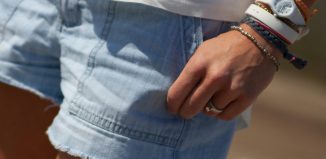Lost art – and memories – reclaimed
By Leah Dunaief
“Woman in Gold” is based on a true story. It is also eerily similar to another true story to which I am privy.
The movie, currently playing in limited release and shortly to move into local theaters, is about an octogenarian Jewish woman who struggles to reclaim paintings looted from her family by the Nazis a half-century earlier.
Dame Helen Mirren plays Maria Altmann, an Austrian who barely escaped with her new husband before the jaws of Nazi death clamped down on Jews and dissidents following Austria’s annexation by Germany in 1938. Ultimately, they lived out their lives in Los Angeles, but much of their extended family stayed and perished in the Holocaust. Their possessions were confiscated, including five paintings by Gustav Klimt. Those paintings, including “Portrait of Adele Bloch-Bauer,” became Austrian icons; but for Maria Altmann, the portrait was simply of her Aunt Adele. The loss of those paintings came to symbolize the terrible loss of her immediate family, her home and her world.
As the years went by, claims of looted property began to surface. In the 1990s, Maria Altmann tried to reclaim her family’s art through the early channels for such action in Austria. She encouraged the son of a friend, a young and struggling lawyer, to represent her. He is the grandson of one of Austria’s most famous musicians, Arnold Schoenberg. He is also an American with little emotional connection to his grandfather’s country, nor Altmann’s cause, but he was initially attracted to the fight for the potential monetary windfall. Their battles with the Austrian government continued for a decade, during which they were aided by an Austrian journalist.
In a similar story, my friend Alice was also born in Austria and lived with her parents and brother in Vienna until the Nazi annexation. Her father was a lawyer, and when warned by one of his clients that he was on the round-up list for the next morning, he managed to escape with his immediate family to the west. They, too, eventually arrived in America, having left all their possessions behind in their hasty flight. One of their pieces of art was an original drawing by Picasso. Alice and her brother, now the rightful heirs, determined to enter claim for their stolen art, especially the most valuable piece by Picasso.
Their claim dragged on through the courts for the better part of a decade, roughly at the same time as that of Maria Altmann although much less in the news. Remarkably, they too were joined in their struggle by an Austrian journalist, whose efforts ultimately helped make the claim successful.
Like Altmann and E. Randol Schoenberg, Alice and her brother, against their will, returned to Vienna for hearings. It was an emotional journey back to the streets of their childhood for them. The film does justice to Altmann’s terrible memories with repeated cuts back in time to the growing atrocities of the late 1930s.
There is another interesting parallel when the claims succeeded. In the movie, the primary Austrian antagonist asks for some sort of shared ownership from Maria Altmann. His suggestion is curtly dismissed by Mirren. As my friend Alice was handed the framed Picasso by an Austrian official, she was told sarcastically that she’d “probably just sell it for the money!” to which she replied, “And that is now none of your business.”
She did not sell it, but rather gave it a position of honor in her Washington Heights apartment. It was, for her, the tiniest satisfaction from a bitterly lost world.
Maria Altmann did sell the painting of Adele Bloch-Bauer to Ronald Lauder, Estée Lauder-heir and owner of the Neue Gallery of Austrian Art on 86th St. and Fifth Ave. in New York. She used the money to help Schoenberg establish his law practice and to help both family members and charities close to her heart.






